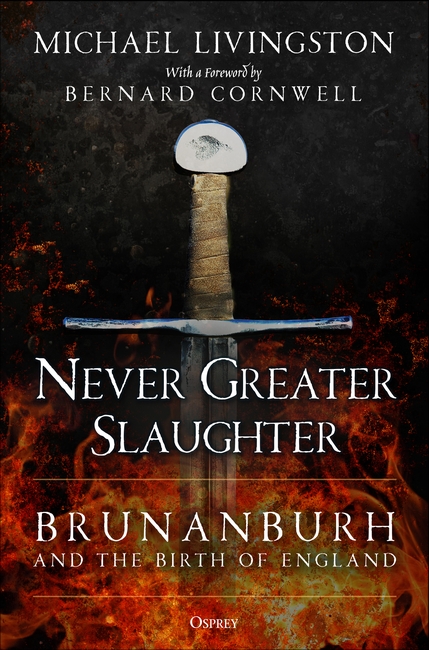Professor Michael Livingston is the author of Never Greater Slaughter: Brunanburh and the Birth of England, the remarkable story of a forgotten fight for England’s survival. In last week’s post, he described what Brunanburh was and how the search for the site began. Today he talks about shovels in the ground...
In last week’s post, I mentioned that many people were unhappy with the idea that Brunanburh was likely fought on the Wirral. Today, I want to talk about the other side of the coin: people who weren’t upset at all. They lived in the towns and villages surrounding the proposed location. They weren’t surprised, but they knew others might be. So they started looking for evidence.
And soon enough, as I explain in Never Greater Slaughter, they began to find things.
The scale of what was being uncovered became clear to me on a beautiful July day in 2019, when I pulled a rental car into a parking lot beside St Andrew’s Church in Bebington. With me were two colleagues: Kelly DeVries, a medieval military historian from Loyola University in Maryland, and Robert Woosnam-Savage, a curator from the Royal Armouries in Leeds and a renowned specialist in the weapons of medieval conflict. Both men are good friends, but more than that they are exceedingly strong scholars. A book on the battle of Crécy that I’d co-written with DeVries (The Battle of Crécy: A Casebook) had recently won a distinguished book prize from the Society of Military History (we would subsequently share a second for Medieval Warfare: A Reader), and Woosnam-Savage was one of the key members of the team that studied the bones of King Richard III. I trusted their scholarship, and I knew they’d be honest with me about their opinions on what we were about to see.
What had brought us to Bebington was a promise of artifacts that had recently been found on the very fields where, in The Battle of Brunanburh: A Casebook, my fellow researchers and I had suggested that the battle of Brunanburh had been fought. Enthusiastic members of Wirral Archaeology had begun field work investigations. They’d found things.
Even as we were parking our car in Bebington to see the finds, Kelly, Robert and I thought it unlikely that we’d see anything we could definitively tie to Brunanburh. As confident as I was in my own Brunanburh research, the chance of finding artifacts from any battle of the period is vanishingly small. We’re talking about lost-needle-in-a-lost-haystack odds. Wirral Archaeology had found things, no question, but the likelihood that those things were battle remains… well, as we got out of the rental car we quietly made plans on how to give them encouragement on the search while we let them down easy on the actual finds.
Greeting us at the door of St. Andrew’s Church was Graham Burgess, the man who’d invited me to look at what Wirral Archaeology had found. We shook hands. We saw a few things on that local site. Then, about an hour later, we headed towards a different location to see the majority of the artifacts they’d gathered.
None of us was even remotely prepared for what we were about to see.
In the end, we met numerous members of Wirral Archaeology – all of them good people who wanted to do the work the right way. And we were shown hundreds of the artifacts that they’d already pulled out of the ground. It was astonishing. I doubt I’ll ever experience such a moment in my professional life again.
As amazing as the artifacts looked, though, it’s important to understand that archaeology – like the earth from which it pulls its secrets – tends to work slowly. Objects that look like one thing might be something else. In Never Greater Slaughter I liken such unearthed objects to a Rorschach Test one tends to see in them what one wants to see in them.
Getting past all that takes time and money – neither of which has been aided by the pandemic. Still, bit by bit, Wirral Archaeology has been getting to the truth of these objects. Among them, for instance, are the kinds of arrowheads used by Vikings from Ireland in battles before the year 950, which for Brunanburh – a battle fought in 937 between the English and Vikings from Ireland – is, well, interesting. Another artifact is a zoomorphic decorative strap end that dates to between the mid-8th and 11th centuries. There’s an Abbasid dirham from 8th-century Baghdad: a coinage found in other 10th-century Viking hoards. And so much more.
What Wirral Archaeology is finding, in other words, seems right on target. And it’s right where it ought to be.
So… has Brunanburh at long last been found?
Maybe. We can’t know yet. As I explain in Never Greater Slaughter, we already had a powerful and objectively convincing case for Brunanburh being fought on the Wirral. It truly fit so well, I believe, that we’d essentially reached the point in the scholarship that for a person to think otherwise — to think it didn’t happen on the Wirral — required a person wanting to think otherwise.
The fact that we might now be able to add the support of material artifacts into the mix makes that case all the stronger. I certainly can’t think of anything else besides Brunanburh that would gather these particular objects in this particular place at this particular time. For a 10th-century battle, bent arrowheads might be as close as we can get to smoking guns.
So increasingly I’ve begun turning my head to the next set of questions I have about Brunanburh, the questions we might start to answer once we know the site of the battle.
What are they? Come along next week and find out!
Never Greater Slaughter publishes next week. Preorder your copy from the website or Amazon today!



Comments
You must be logged in to comment on this post. Click here to log in.
Submit your comment